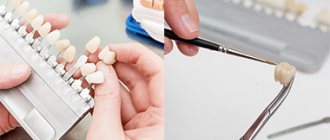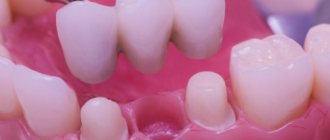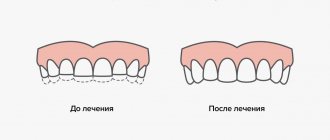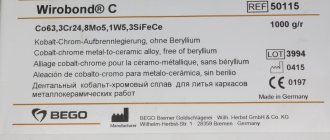What is a metal-ceramic crown?
Today, the choice of materials for making dental crowns is very wide: ceramics, zirconium dioxide, and plastic, but metal-ceramics continues to be the most popular and affordable. At the moment, metal ceramics are a kind of gold standard in dentistry, since similar designs have been used by doctors for many years and have proven themselves to be good.
Metal-ceramic crowns are a “cap” with machined fissures, which is placed on a ground tooth and completely imitates its shape, including all anatomical formations. The basis for the structure is a metal frame, which is covered on top with a layer of ceramics, indistinguishable in color from natural enamel. The prosthesis is secured to the ground dental tissues using special composite or glass ionomer cement. In case of severe destruction, a metal tab is first installed, which serves as a reliable basis for the crown. Metal-ceramics are also used for the manufacture of bridges and clasp dentures supported both on the patient’s own teeth and on dental implants. In the latter case, the use of implants with metal abutments is recommended.
Types of crowns
The number of missing teeth, the presence of dentures and other individual characteristics of the patient determine what type of crown is suitable for him. It is impossible to determine this in absentia, since it requires an examination by a specialist.
Bridges
Suitable for people who have lost more than one tooth. The prosthesis is made for all missing units, and its parts are connected by a metal bridge. To secure the crowns, you need healthy chewing teeth. Only complex prosthetics are performed in this way.
Implant supported crowns
If the patient has implants, the crown can be secured to them. This will prevent the destruction of healthy teeth, which can occur due to excess stress. But the method is only suitable for those who already have implants installed.
Crown for one tooth
If one tooth is destroyed, a crown can be installed only on it. This usually happens after deep caries or injuries. Before installing a crown, the condition of the periodontium, jaw and gum tissue is assessed. Sometimes additional operations are performed to build up the bone plate.
Fixation with a pin
The rarest method of prosthetics is installing a crown on a pin. It is quite traumatic and carries a risk of complications, so it is almost never used. If other methods of prosthetics are not available to the patient, the crown is installed on a pin, but this is done in several stages under the supervision of specialists at each of them.
Pros and cons of a metal-ceramic crown
Among the advantages of metal-ceramic crowns is, first of all, their strength. Therefore, in most cases they are installed on chewing teeth. Undoubtedly, they look much better than purely metal crowns. In general, metal-ceramic crowns imitate real teeth well, but with the advent of new materials in prosthetics, preference in restoring anterior teeth began to be given to all-ceramic structures. When a combination of reliability and aesthetics is needed in the chewing area, then the best choice would be ceramic prostheses based on zirconium dioxide.
Make an appointment
right now!
Akhmedkhanov Said Rashidovich
Surgeon, Therapist, Orthopedist, Hygienist, Implantologist
Possible complications after prosthetics
After installing a metal-ceramic denture, you need to be prepared for possible complications. With the correct medical actions and proper quality of the material used, complications are minimized. But sometimes the patient may encounter problems such as gum inflammation and gingivitis.
Inflammation appears due to the crown itself, which for some reason was installed incorrectly. This may be compounded by poor oral hygiene.
Another unpleasant symptom may be pain under the crown. Often, pain indicates periodontitis, which occurs if the crown was placed on a non-pulpless tooth.
Blueness of the gums may also be observed, which occurs due to the reaction of the denture to the gum. In this case, the patient does not feel any pain. In addition, the metal base is sometimes visible under the ceramic layer of the prosthesis.
If you experience any unpleasant or painful sensations after dentures, you must immediately contact your dentist for appropriate diagnosis and treatment.
What are the differences between metal-ceramic crowns?
Indeed, many patients wonder: what is better - zirconium crowns or metal-ceramics? Roughly speaking, both structures are metal-ceramic, but zirconium is a “white” material that does not shine through the ceramic, as sometimes happens with ordinary metal. Therefore, today ceramic crowns on a zirconium frame are close in aesthetic qualities to all-ceramic crowns, but at the same time they have the same strength as metal-ceramics. However, prices for such prostheses are higher than for metal-ceramic structures without the use of zirconium.
The question of which is better - metal-ceramic or ceramic crowns cannot be answered unequivocally. The choice is made depending on the indications and budget. So, if prosthetics of the frontal group of teeth is necessary, it is recommended to choose solid ceramics. It is aesthetic metal ceramics. Typically, such crowns are placed on teeth where the chewing load is less, since the metal-ceramic frame is stronger. Regarding the issue of price, a metal-ceramic crown is, of course, cheaper.
Installation process
The crown is installed in several stages. The number of visits to the doctor depends on the condition of the teeth and the chosen prosthetic method.
Laboratory stage
A cast of the patient's jaw is sent to the laboratory to create a plaster model of the jaw. After complete drying, the desired part is cut out. Using it, a wax prototype is made.
The model is fixed on the base and filled with a special mixture. It goes into the oven for 4-5 hours. The resulting mold is immediately filled with the alloy while it is hot. The future crown is left in this form until it hardens completely. The piece is then polished and sanded to achieve the perfect shape.
Removing the temporary structure
When the permanent crown is ready, the temporary structure is removed. It only takes a few minutes, after which prosthetics can be applied.
Installing a crown on a tooth
Before fixing the crown, a fitting is performed. If it is uncomfortable or the enamel color is not suitable, it is sent for revision. When the crown is perfect, it is secured with cement. The strength of the fixation must be checked after the material has hardened.
Monitoring the situation after installation
After fixing the crown, the doctor checks how correctly it is installed. To do this, an x-ray is taken. Only after his assessment can the patient go home. If you experience strange sensations, you should call your dentist to clarify your condition and the need for a second visit.
Our advantages
At the Beryozka clinic, the material for the crown and its type are selected individually. Each patient is given an approximate treatment estimate so that he can clearly see what he is paying for. A transparent work system, professionals, the latest equipment and materials ensure the ideal result of prosthetics at the Beryozka clinic. A polite attitude and the ability to quickly get an appointment are the key to pleasant emotions from visiting a dentist.
Types of metal-ceramic crowns
Metal-ceramic crowns have several classifications: according to the frame material and according to the ceramic material. Thus, according to the frame material, crowns are distinguished based on a chromium-nickel alloy, based on a cobalt-chromium alloy, and based on a gold-platinum (palladium) alloy (based on the so-called “noble alloys”). There is also another material that is used quite rarely - titanium alloy. Each of these types of metal-ceramic crowns has its own pros and cons. Traditionally, the most popular material is cobalt-chromium alloy. Based on the ceramic material, a distinction is made between conventional (high-temperature) and low-temperature ceramics. Low-temperature ceramics based on “noble” alloys look more aesthetically pleasing.
Stages of manufacturing metal-ceramic prostheses
How are metal-ceramic crowns made, and how long does it take to make them? Let's sort it out in order. Production includes the following stages:
- taking impressions after installing abutments on the implant,
- sending casts to the laboratory and making a working model: all anatomical formations must be made on it - tubercles and fissures. If a three-dimensional scan of the oral cavity is additionally carried out, then the digitized data is sent to a machine that grinds out a metal base - “cap”,
- fitting of a workpiece made by casting or milling: if necessary, defects are eliminated,
- lining a metal workpiece with ceramics, firing, glazing and polishing,
- fixation of the finished product to the abutment or to the base of the prosthetic gum structure (if the prosthesis is extended).
How long does it take to make a metal-ceramic crown? The production time depends on the skill of the orthopedist, dental technician, equipment and workload of the dental laboratory. On average, production takes 1-2 weeks, plus or minus 5 days. If production is carried out by a third-party laboratory located far from the implantology clinic, then the production time may increase by 2 weeks.
Let's talk further about how a metal-ceramic crown is placed on an artificial tooth.
Indications and contraindications for metal-ceramic crowns
The indications for installing a metal-ceramic crown are the same as for crowns made of other materials. The main one is the index of destruction of the coronal surface of the tooth, equal to 0.6. Also, indications for installing a metal-ceramic crown are:
- any non-carious lesions, for example, fluorosis or enamel hypoplasia;
- abnormal development and position of the front teeth in adults, which for any reason cannot be eliminated by orthodontic methods;
- pathological abrasion or wedge-shaped defect;
- aesthetic defect in the crowns of natural teeth (changes in color and shape, loss of shine, etc.);
- inconsistency of existing artificial crowns with aesthetic and functional requirements;
- metal-ceramic crowns can also be used as a splinting structure for mild to moderate periodontitis;
Each of the above indications should be considered in the context of a specific clinical case. Contraindications include, for example, bruxism, as well as periodontitis, accompanied by severe tooth mobility. In addition, fixed prosthetics on implants also involves the use of metal-ceramic crowns.
Is it possible to put metal-ceramic crowns on the front teeth?
It is possible if the patient’s budget does not allow for all-ceramic crowns. There are no medical contraindications to the manufacture of metal-ceramic crowns on the frontal teeth. However, aesthetics in this case recedes into the background. Such crowns will not look very natural. Therefore, it is still better not to place metal-ceramic crowns on the front teeth.
What are the special indications for metal-ceramic prosthetics?
Almost every patient can choose this type of prosthetics for themselves. But there are certain indications when the dentist recommends installing dentures made of metal-ceramics:
- If it is necessary to restore lost chewing teeth.
- If the existing dental structures (bridges, plastic crowns, etc.) do not suit the patient aesthetically.
- If there is a need to replace two or more teeth on a dental bridge.
- If there are defects in the crown standing on the tooth (deformation, color changes, loss of shine)
- If the crown has collapsed, it is not possible to restore it by installing a filling or dental inlays.
- If pathological abrasion of tooth enamel is observed.
Installing a metal-ceramic crown on a tooth
- The first stage of installing a metal-ceramic crown can be called clinical. The doctor treats the tooth and its canals, prepares dental tissue for the future crown and takes an impression.
- After this, the laboratory stage begins: in the laboratory, a crown frame is made, which we then try on, check its reliability and fit to the tooth, correct defects, if any, and also choose the color of the future structure. The frame is then taken back to the laboratory, where a technician applies ceramic paste to it.
- When the crown is ready, the doctor invites the patient to an appointment and installs it.
While the prosthesis is being manufactured, which can last from one to two weeks, a temporary crown is installed on the tooth.
Metal-ceramic crown with shoulder
There are no metal-ceramic crowns with a shoulder. The tooth is ground with a shoulder, and the metal-ceramic crown is made with a ceramic shoulder. That is, the edges of the metal frame of the crown are lined with a special “shoulder” ceramic mass. This is done to improve the aesthetics of prosthetics with metal-ceramic crowns, as well as to prevent “cyanosis” (translucency of the metal frame) in the crown-tooth transition zone.
Dental crowns: types, installation, care, problems, service life
Dental crown - This is a “attachment” in the shape of a tooth, which is placed on top of it in order to cover the tooth, restore its shape, size, strength, and improve its appearance.Once cemented, crowns completely enclose the entire visible portion of the tooth located at and above the gum line.
Why do you need a dental crown?
A dental crown may be needed in the following situations:
- To protect a weakened tooth (for example, by caries) from decay, or to hold together parts of a decaying tooth;
- To restore an already damaged tooth, or a tooth that has been severely worn out;
- To isolate from the external environment and strengthen a tooth with a large filling in cases where there is too little dental tissue left;
- To hold a dental bridge in place;
- To cover a tooth that has lost its natural shape or has largely lost its natural color;
- To cover a dental implant;
- To change the appearance for aesthetic purposes.
For children, crowns can be installed on their first (baby) teeth in order to:
- Save a tooth that has been so damaged by caries that it cannot support a filling;
- Protect the teeth of a child at high risk for dental caries, especially when the child has difficulty maintaining daily oral hygiene;
- Reduce the frequency of use of sedatives and general anesthesia in children who, due to age, behavioral characteristics, or medical factors preceding treatment, are unable to fully meet the requirements for the behavior of dental patients.
In such cases, your pediatric dentist will likely recommend a stainless steel crown.
What types of dental crowns are offered?
Permanent crowns are all-metal (they are made, for example, from stainless steel, gold, gold-based alloys), they are also made from porcelain fused with a metal base, solid rubber and ceramics.
- Stainless steel crowns are prefabricated and placed on permanent teeth, usually as a temporary measure. Such a crown protects the tooth or filling for the period during which a permanent crown is made from another material. For children, stainless steel crowns are usually installed on previously prepared baby teeth. The crown covers the entire tooth, protecting it from further development of caries. When a baby tooth falls out to make room for a permanent tooth, the crown naturally falls out with it. Typically, stainless steel crowns are placed on children's teeth because they do not require multiple visits to the dentist for fitting, and therefore are not as expensive as custom crowns and the preventive services needed to keep teeth healthy without a crown.
- Crowns made from other metals are made using gold alloys, as well as palladium alloys and base metal alloys (such as nickel or chromium). Compared to other types of crowns, installing metal crowns requires the removal of less tooth tissue, and wear on adjacent teeth is minimized. Metal crowns can withstand the load applied when biting and chewing well and, perhaps, are more durable than all others. In addition, metal crowns rarely chip and rarely break. The main disadvantage is their metallic color. But metal crowns are a good choice for molars because they won't be visible to other people.
- Porcelain crowns with a metal backing can be matched to the color of adjacent teeth, unlike metal crowns. However, when wearing these crowns, adjacent teeth are subject to more wear and tear compared to metal or rubber crowns. The porcelain portion of the crown may also chip or fall off. Metal-porcelain crowns are very similar to natural teeth; in this regard, they are superior only to all-ceramic crowns. However, sometimes the metal underneath the porcelain can show up as a dark feature, especially near the gum line. This effect increases as the gum volume decreases. These crowns can be a good choice for both front and back teeth.
- Solid rubber crowns are cheaper than other crowns. However, over time they wear out and are more susceptible to cracks than metal-porcelain ones.
- Crowns made from solid ceramic or solid porcelain provide the most natural appearance and are best suited for people with metal allergies. However, they are not as durable as porcelain-metal ones, and they wear down adjacent teeth a little more than metal or rubber ones. All-ceramic crowns work well for front teeth.
- Temporary or permanent ? Temporary crowns can be made in the dentist's office, while permanent crowns can only be made in a laboratory. Temporary crowns are made from acrylic or stainless steel and can be used until the permanent ones are made in the laboratory.
Preparing a tooth for a crown?
Preparing a tooth for a crown usually requires two visits to the dentist. During the first, the tooth is examined and prepared, and during the second, a permanent crown is placed.
First visit: examination and preparation of the tooth
During your first visit to prepare for a crown, your dentist will take several x-rays to examine the roots of the tooth that will receive the crown and the surrounding bone. If a tooth has significant decay, or there is a risk of infection or damage to the tooth's pulp, root canal treatment will have to be performed before a crown can be placed.
Before the crown process begins, your dentist will administer anesthesia to numb the tooth and surrounding gum tissue. Then the tooth on which it is planned to install a crown will be ground from the chewing surface and on the sides to make room for the crown. The volume of dental tissue to be removed depends on the type of crown that is planned to be used (for example, all-metal crowns are thinner and therefore require the removal of less dental tissue than all-porcelain or metal-porcelain crowns). If, on the other hand, a significant amount of tooth structure is missing (due to decay or damage), the dentist may use a filler to “fill in” the tooth, giving it the ability to support a crown.
After adjusting the shape of the tooth, the dentist will take an impression of the tooth, which is necessary to give the correct shape to the dental crown. Impressions of the teeth above or below the tooth receiving the crown will also need to be taken to ensure that the crown will not affect your bite. The impressions are sent to a laboratory where the crown will be made. It is usually sent to the dentist's office in two to three weeks. If the crown is made of porcelain, the dentist will also select a shade that most closely matches the color of the adjacent teeth. During this first visit to the dentist, he will make a temporary crown to cover and protect the prepared tooth while the permanent one is made. Temporary crowns are usually made of acrylic and held in place with a limited-lasting cement.
Second visit: obtaining a permanent dental crown
During the second visit, the dentist will remove the temporary crown and check how the permanent crown fits on the tooth and how well it matches the color of the adjacent teeth. If both of these issues are resolved positively, the dentist will apply local anesthesia to numb the tooth, and the new crown will be placed in place, secured with a permanent cement.
Caring for a temporary dental crown
Because temporary dental crowns are exactly what they say - a temporary solution that only works until the permanent crown is ready - most dentists offer few precautions when handling them. These include the following:
- Avoid sticky and chewy foods (such as hard candy) and chewing gum, as they can grab the crown and pull it off the tooth.
- Try to chew as little as possible on the side of your mouth where the temporary crown is installed. Transfer the main effort of chewing to the other side of the mouth;
- Avoid chewing hard foods (such as raw vegetables) as this may cause the crown to become dislodged or broken;
- When flossing your teeth, pulling it outward, do it not sharply, but smoothly. By sharply pulling the floss from between the teeth in a normal manner, you can rip the temporary crown off the tooth.
What problems can arise when wearing a dental crown?
- Uncomfortable sensations or sensitivity . Your tooth that has received a new crown may become more sensitive immediately after the procedure, when the anesthesia used for it begins to wear off. If the tooth that has been crowned still has nerve in it, you may experience some sensitivity to heat and cold. Your dentist may recommend that you use a special toothpaste for sensitive teeth. The pain and sensitivity experienced when biting usually means the crown is too high for the tooth. If this is the case, contact your dentist - he can correct this problem.
- Breakage of crowns . Crowns made from solid porcelain sometimes suffer mechanical damage. If the chip on the surface of the crown is small, it can be repaired with a rubber-based composite material, leaving the crown in the mouth. If the crown has suffered extensive damage, it will have to be replaced.
- Loosening of the crown . Sometimes the cementitious substance is washed out from under the crown. This not only loosens the crown, but also allows bacteria to enter, causing decay in the remaining tooth under the crown. If you feel that your crown is starting to loosen, contact your dental office.
- Crown loss . Sometimes crowns fall out. This occurs due to improper fit, insufficient cementitious substance, or too little dental tissue to support the crown. If this happens, you should first clean the crown and front side of the tooth. You can temporarily put the crown back on using dental adhesive or a limited-life cementing agent available in stores. Contact your dental clinic immediately. The dentist will give you specific instructions on how to care for the tooth and the fallen crown for the day or two before he or she examines you. The dentist may be able to reattach the crown in place; otherwise you will have to make a new one.
- Allergic reaction . Since crowns are usually made not from pure metals, but from their alloys, including porcelain, an allergic reaction to the metals or porcelain used in the production of crowns may occur. But this happens extremely rarely.
- A dark stripe that is visible in the crown and runs adjacent to the gum line. A dark line running through the crown adjacent to the gum line is normal, especially if your crown is made of porcelain with a metal backing. This dark line is simply the metal component of the crown that is visible through the porcelain.
What are three-quarter onlays and crowns?
Onlays and three-quarter crowns are types of dental crowns. The difference between these and other crowns, which we have previously discussed, is the way they cover the tooth. A “traditional” crown covers the entire tooth, while onlay and three-quarter crowns only partially cover the tooth.
How long do dental crowns last?
On average, dental crowns last from 5 to 15 years. The lifespan of a crown depends on the degree of wear, oral hygiene and the patient’s personal habits. You should get rid of habits such as teeth grinding, clenching your teeth, you should not chew ice, bite your nails, or open packages with your teeth.
Does a tooth with a crown need special care?
Although a tooth with a crown does not require special care, remember that having a crown on a tooth does not mean that it is protected from tooth decay or periodontitis. Therefore, continue to maintain good oral hygiene, including brushing your teeth at least twice a day and flossing them daily. You should pay special attention to the area surrounding the crown, where the gum meets the tooth. Rinsing the mouth with bactericidal solutions will also help.
How much do crowns cost?
The cost of crowns varies depending on what region you live in and the type of crowns. For example, porcelain crowns are typically more expensive than gold crowns, and gold crowns are typically more expensive than porcelain-metal crowns. Typically, crowns cost from 12,000 to 25,000 rubles each.
Source: dentaldaily.ru
Service life of metal-ceramic crowns
How long does a metal-ceramic crown last? Modern products last on average about 10 – 12 years. If a chip occurs on the metal-ceramic crown of the ceramic layer, then in some cases repair is possible. If it did not occur due to the development of secondary caries under the prosthesis, but as a result of mechanical damage, the dentist assesses the volume of the chip and, if the metal frame is not exposed, restoration of the metal-ceramic crown can be carried out using grinding or composite materials. If a serious chip occurs on the metal-ceramic crown, the prosthesis must be replaced.
Once the service life of the prosthesis has expired, the structure must be replaced. This is due to the fact that the special cement on which the structure is attached begins to deteriorate over time under the influence of saliva and other factors. If the crown is not removed in time, a problem may arise such as secondary caries, developing under the cap and at its junction with the tooth tissue.
What is a dental crown
The visible part of a natural tooth is the crown. It is most often destroyed due to caries, trauma or the process of demineralization. It can be restored with an artificial prosthesis - a dental crown. It can be temporary - for the period of treatment, or permanent - for every day. In some cases, crowns are used to correct the shape of implants when they are damaged.
Caring for metal-ceramic crowns
The rules for caring for metal-ceramic crowns are practically no different from the rules for caring for natural teeth. However, less interdental plaque and tartar are formed on the metal-ceramic surface than on natural enamel. For care, it is necessary to use dental floss, brushes and, preferably, an irrigator to avoid the accumulation of plaque at the transition boundary from the crown to the tooth. During the professional hygiene procedure, the structure must be polished. Otherwise, timely attendance at preventive examinations and thorough daily cleaning will help the metal-ceramic crown serve its full service life.
Advantages and disadvantages
When considering the pros and cons of metal-ceramic dental crowns, you need to know that they have many more advantages than disadvantages. Let's look at the pros and cons in more detail.
What are the advantages of such prostheses:
- strength and durability: the service life of metal-ceramic dental crowns is more than 10-12 years, if the base is made of gold, then they will last more than 15 years, which is similar to prostheses made of zirconium dioxide,
- aesthetic appearance: ceramics are presented in a wide variety of shades; thanks to a special scale, the doctor and patient will be able to choose the color of new teeth in accordance with the shade of those remaining in the oral cavity. In addition, throughout its entire service life, high-quality ceramics do not break off from the base, are not damaged or change their original color,
- accessibility: metal-ceramic dentures can be made by a dental technician in any dental laboratory,
- hygiene: a small amount of plaque forms on the surface of the dentures, which improves the condition of the oral cavity. But this is only possible if the patient regularly undergoes professional oral hygiene, cleaning of dentures and takes full care of new teeth on implants at home,
- low cost.
What are the disadvantages:
- allergic reactions to metal are possible,
- are not recommended for the restoration of front teeth, since a thin layer of ceramic, of course, creates an ideal appearance, but when exposed to light, the gray metal base can show through. And the gums around the prosthesis acquire a bluish tint over time (except for products on the shoulder mass). The solution is a prosthesis base and abutment made of gold or zirconium dioxide,
- impact on neighboring teeth: metal is much stronger than the material of natural teeth that are preserved in the oral cavity and, in contact with them, can cause their gradual destruction and abrasion of the enamel.
How much do metal-ceramic crowns cost in Moscow?
The price of metal-ceramic crowns per tooth depends on the price category of the clinic in Moscow, the metal used to make the frame, the qualifications of the prosthetist and dental technician, the complexity of the clinical case and a number of other factors. The price of a metal-ceramic crown for one tooth starts from 7,000 rubles. However, it does not include additional costs. The total cost of a dental crown made of metal ceramics, including taking impressions, installing a temporary crown and fixing a permanent one, is about 10,000 rubles, which, in general, is very inexpensive in Moscow.
Publisher: Expert magazine about dentistry Startsmile.ru
Stages of metal-ceramic prosthetics
Any types of dental crowns are installed in stages and metal-ceramic products are no exception. It is important not only to install prostheses in a high-quality manner, but also to properly prepare for prosthetics.
Therapeutic stage
The quality characteristics of prosthetics directly depend on the correctness of therapeutic procedures. The essence of preparatory therapy is as follows:
- diagnostic measures. An x-ray is taken, from which the dentist determines the actual condition of the root canal, the presence or absence of inflammatory processes in it;
- If any violations are found, then endodontic treatment followed by canal filling is mandatory. In some cases, complete pulp removal is not required and the teeth remain “alive” under the crown;
- if more than half of the coronal part is destroyed, then the doctor installs a stump tab. It is necessary for a more durable fixation of the future crown.
During the period of implementation of the metal-ceramic structure, a plastic temporary crown is installed in place of the defect, if necessary.
Preparing a tooth for prosthetics
This stage consists of the following procedures:
- When the root canals have been treated and filled, the doctor begins to grind the enamel to a thickness corresponding to the prosthesis. On average, it is necessary to remove 1.5-2.0 mm of native enamel;
- impressions are made using silicone mass and transferred to dental technicians;
- In the workshop, the frame is first made and after fitting, the structure is brought to aesthetic perfection.
The color for painting the ceramic coating is chosen so that it fully matches the shade of the patient’s teeth.
Crown installation
The prosthesis, made in a dental prosthetic laboratory, is installed in the patient’s oral cavity and fixed with a temporary cement composition. This is necessary so that the patient understands whether wearing a crown will be truly comfortable for him. If the patient does not experience any discomfort for several months, the prosthesis is fixed with a permanent mixture. When there are complaints of discomfort or pain, the crown is sent for correction.
How much does prosthetics cost?
The price of metal-ceramic dentures on implants depends on the materials (their quality and quantity), manufacturing method, equipment of the dental laboratory and requirements for implantation. The most budget option for a crown starts at 7,500 rubles. If the price includes a titanium abutment, then add another 7-15 thousand. But all this is indicated without the cost of the implant (the price of which can be 15-70 thousand depending on the brand and model).
Author: Vasiliev A. A. (Thank you for your help in writing the article and the information provided)
Metal ceramics or zirconium: which is better?
1) Many patients ask: metal-ceramics or zirconium - which is better for prosthetics of front teeth. Modern metal ceramics, when using good expensive ceramic mass (provided that it is done by a talented dental technician!), will practically not differ from your own teeth. But in reality, only a rare patient will be able to obtain such an aesthetic result, and in any case, it will not be cheap.
A few years ago, we recommended making ceramic crowns made of zirconium dioxide only for chewing teeth, because... In the area of the front teeth, the zirconium dioxide looked artificial. Modern zirconium crowns are made using the “Multi-leyer” technology, which means the use of special zirconium dioxide blocks that have a gradient of color and transparency (like real teeth). Zirconium crowns using multi-layer technology have excellent aesthetics, but a higher cost.
But in most cases, crowns are made from cheap zirconia blocks that are bright white and lack a gradient of color or translucency. As a result, the crowns look artificial and are very different from the patient’s neighboring natural teeth. Therefore, if we are talking about the front teeth, then we recommend, first of all, not metal-ceramics, but monolithic zirconium crowns using the “multi-layer” technology. You can read more about such crowns at the link above.
Important: but in some cases, even such zirconium crowns may not allow you to achieve an ideal aesthetic result. The problem is that zirconium dioxide does not have a very large number of color options (compared to feldspathic ceramic crowns or Emax glass ceramics). An even higher level of aesthetics on the front teeth can be achieved using crowns made not from zirconium dioxide, but from another type of ceramic – lithium disilicate.
An example of the best material based on it is the pressed ceramics “IPS Emax” (“Emax PRESS” material). It is from these materials that we recommend making crowns for the front teeth in general for all patients, but especially for those who have high transparency of tooth enamel, or if complex color solutions are required. But with the help of this material it is possible to make single crowns, as well as bridges with a length of no more than 3 units.
2) Zirconium dioxide or metal ceramics: which is better for chewing teeth
Ceramic crowns made of zirconium dioxide for chewing teeth are the best alternative to metal-ceramics, but only if crowns made of monolithic zirconium dioxide are used. There is also an option for making zirconium crowns, where only the frame will be made of zirconium, which is covered on the outside with a layer of ceramic mass. But this “layered” option has a high risk of ceramic chips (according to statistics, after 3/5 years, chips are observed in at least 6/10% of patients, respectively).
Also, if you need to make only a single crown for a chewing tooth (and at the same time you want perfect aesthetics), it can also be made from IPS Emax PRESS ceramics. But only single crowns can be made from this material on chewing teeth. If you need a bridge, it is better to choose crowns made of monolithic zirconium dioxide, and only in the latter case - metal ceramics.
How does the prosthetics process work?
The entire process of prosthetics - from the moment of grinding teeth for crowns to fixing the finished crowns - takes on average 10-14 days. If you are promised crowns will be made in less than a week, then you can say with almost 100% confidence that it will be clumsy, low-quality work. But the most important thing before this is high-quality preparation of the supporting teeth (except in cases where the teeth can be kept alive).
1) Therapeutic tooth preparation –
First of all, an x-ray is taken. If it shows the presence of a focus of inflammation at the apex of the root, the focus of inflammation will first need to be treated, and the root canals will subsequently be sealed. If the tooth canals have already been previously filled, but poorly, then the canals are re-treated even if there is no visible source of inflammation at the root apex.
If there is caries or old low-quality fillings on a tooth, the caries is treated, the fillings are changed, but taking into account the need to first depulp the tooth. This process involves removing the nerve followed by filling the root canals, and is carried out in the presence of pulpitis or periodontitis of the tooth. Living single-rooted teeth are also most often subject to depulpation, but multi-rooted teeth can most often be left alive under metal-ceramics.
If the tooth is severely damaged - when the crown of the tooth is destroyed by no more than 1/2 - usually a pin is screwed into the root canal, and then the crown part of the tooth is restored using filling material (Fig. 21-22). The pin allows you to strengthen the restored crown part of the tooth and prevent it from breaking under chewing loads.
However, when the crown of the tooth is destroyed almost to the root or only very thin walls remain, to restore the tooth you need to use not a pin, but a metal stump inlay (Fig. 18-19). The metal-ceramic crown will then be fixed onto this tab. The use of a stump tab will increase the strength of the structure and will prevent the crown from breaking off under significant load.
2) Stages of prosthetics –
After the tooth has been prepared for prosthetics, it is ground on all sides to the thickness of the future crown (Fig. 22-23). Next, the orthopedic dentist takes an impression of the teeth and sends it to a dental laboratory, where a metal-ceramic crown is made by a dental technician. The normal time frame for metal-ceramic prosthetics is 10-14 days.
Good specialists are usually busier than others, and therefore too short deadlines and low prices will be suspicious. It is important to understand that there are very few good dental technicians and orthopedic dentists, and remuneration for their labor costs clinics more, which also affects the price of prosthetics.
Metal-ceramic crown: before and after photos
During the manufacture of metal-ceramic crowns, the patient is always offered to make temporary crowns made of plastic. Temporary crowns are necessary both for aesthetics and to protect fragile, ground teeth from the aggressive acidic environment of the oral cavity. This will cost an additional 2000 rubles for 1 temporary crown. If this is expensive for you, then it is advisable to ask the doctor to treat the ground teeth with a special preparation - “dentin-sealing liquid”.
Important: taking into account the cost of preparing each abutment tooth for prosthetics (which can range from 3,000 to 10,000 rubles per tooth, depending on the complexity), as well as the cost of temporary crowns made of plastic - metal-ceramic crowns, the price in Moscow sometimes reaches the cost of installing an economical implant. class, type MIS (Israel).
Therefore, often, if we are talking about prosthetics for a single missing tooth with a bridge of 3 crowns, sometimes it is cheaper and more reliable to implant 1 tooth. Moreover, this can allow you to keep the neighboring teeth (on the edges of the missing one) alive and healthy.
Metal ceramics on teeth: what is important for patients to know
If you have already chosen metal-ceramic crowns for prosthetics, then it is very important to understand that their different manufacturing options can differ greatly from each other (in their aesthetic properties, reliability and service life). In this article we will talk about several options for metal ceramics, which differ greatly from each other in quality and aesthetics.
But the most important thing at the first stage (without which the crown a priori cannot be of high quality) is
- this is high-quality endodontic preparation of teeth (we are talking about high-quality filling of root canals when necessary),
- quality of tooth preparation for crowns (“turning”),
- quality of impression taking.
For example, if the root canals in a tooth are poorly sealed (according to statistics, this happens in more than 60% of cases), then inflammation will develop at the tops of the tooth roots. This means the need to remove the crown, re-treat the tooth and new prosthetics. Therefore, insist on control images after canal filling, and to be sure, it is better to show these images to another doctor.
Secondly, grinding of teeth for crowns should be carried out with a “ledge”. But even if these first 2 points are performed perfectly, the crowns may still be of poor quality if a poor-quality impression is made. For example, to save money, the doctor will use cheap impression compounds, such as alginate mass or C-silicone. A good impression mass is A-silicone, or even better – polyester mass, which gives a super-accurate reproduction of oral tissues.
Important: improperly ground teeth or a poorly taken impression will result in the crown not fitting accurately and tightly to the neck of the tooth. The latter threatens to leak saliva and get bacteria under the crown, which will cause rotting of the tooth under the crown. Due to inaccurate manufacturing, doctors sometimes file finished crowns with a drill, which indicates the low quality of the manufactured crowns.
Types of metal-ceramic crowns –
1) The first is traditional metal-ceramic crowns, in which the metal frame is cast from a cobalt-chromium alloy (CHS). Those. in this case, the crowns will have a cast metal frame, and the important point here is that different manufacturers produce cobalt-chromium alloys of different compositions. They are united only by the approximate content of cobalt - about 64%, chromium - up to 30%, but the devil lies in the composition of minor components - such as tungsten, molybdenum, nickel and others.
It is very important that the dental clinic (its dental laboratory) does not use cheap CCS options containing nickel and beryllium. The presence of such components is fraught with a high risk of developing a local allergic reaction to metals, as well as the development of inflammation of the gums around the crowns. The second important point is that during standard production, a metal-ceramic crown is lined with ceramic mass on all sides, but with the exception of the ledge area!!! Those. the lowest edge of the metal frame, which will be located under the gum, is not covered with ceramics (Fig. 7, 9).
Metal-ceramics without/with ceramic shoulder mass –
You might think that since the edge of the metal frame is hidden by the gum, it doesn't affect anything... but that's not true. Firstly, the gray metal will shine through the gum, giving it a gray/bluish color. If you are using metal-ceramic prosthetics for your chewing teeth, this may not be important. But if we are talking about the front teeth (and even more so if your gums are exposed when you smile), the aesthetics will be extremely unsatisfactory.
Secondly, in most cases, slow gum recession will occur in the area of metal-ceramic crowns, which sooner or later will lead to exposure of the edge of the metal frame, which was previously covered by the gums. To solve these problems, metal-ceramic crowns with “shoulder mass” were developed. In this version of crowns, the edge of the metal frame is also lined with ceramics, and the edge can be lined both along the entire circumference of the crown, and only from its front surface (Fig. 8).
The price of metal-ceramic crowns with a ceramic “shoulder mass” starts at least 12,000 rubles in the most inexpensive clinics (however, this price implies that only economy-class ceramic mass will be used). When using high-quality ceramic mass, which makes it possible to give metal-ceramics excellent aesthetics, the price for metal-ceramic crowns with shoulder mass cannot be lower than 16,000 - 18,000 rubles per unit. It should be noted that, in principle, for that kind of money you can already get a ceramic crown made of pressed ceramics.
2) Secondly , there is metal ceramics, the cast metal frame of which is made of precious metal alloys (Fig. 9). In addition to the fact that precious metals react less with the aggressive environment of the oral cavity, they make the crown more similar to a real tooth. This is due to the fact that the ceramic mass is slightly translucent, and the metal frame containing gold will give the ceramic a natural, slightly yellowish tint. But in principle this makes no sense, because... for that kind of money you can make excellent crowns from metal-free ceramics.
3) The third option is metal ceramics on a milled metal frame. In this case, the metal frame is not cast from molten metal, but is milled on a machine with digital program control. This technology is called CAD/CAM, and in exactly the same way not only frames for metal-ceramic crowns and bridges are made, but also zirconium crowns (ceramic crowns made of zirconium dioxide).
Milling of the metal frame of crowns is carried out from special blanks, for example, in the form of disks. Such discs are made from a cobalt-chromium alloy (CHA), but in this case it is also very important that the clinic uses higher quality and more expensive discs, where the CCH does not contain nickel and beryllium. Otherwise, the patient may experience an allergic reaction and inflammation of the gums around the crowns. What is the advantage of a milled metal frame over one made by casting?
The most important thing here is the unprecedentedly high precision of the fit of the crown to the neck of the tooth (i.e. in the area of the ledge), which significantly increases the service life of the crowns. And secondly, which is probably the most important thing, such high precision is needed not only for single metal-ceramic crowns, but for the manufacture of extended bridges made of metal-ceramics. Those. if your bridge consists of a large number of crowns (4 or more), then you should definitely opt for a milled metal frame.
Metal frame milling (CAD/CAM):
If the metal-ceramic crown has a milled frame, then the price for such metal-ceramics in Moscow will be at least 18,000 - 20,000 rubles (for 1 unit). In principle, the cost of a milled frame is not much higher than a cast metal frame. However, many clinics may discourage you because... They may not have their own milling equipment, which would require a third-party dental laboratory to fabricate such a frame, leaving their own laboratory out of work.











